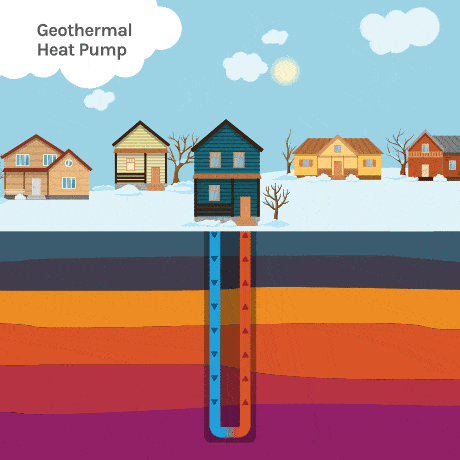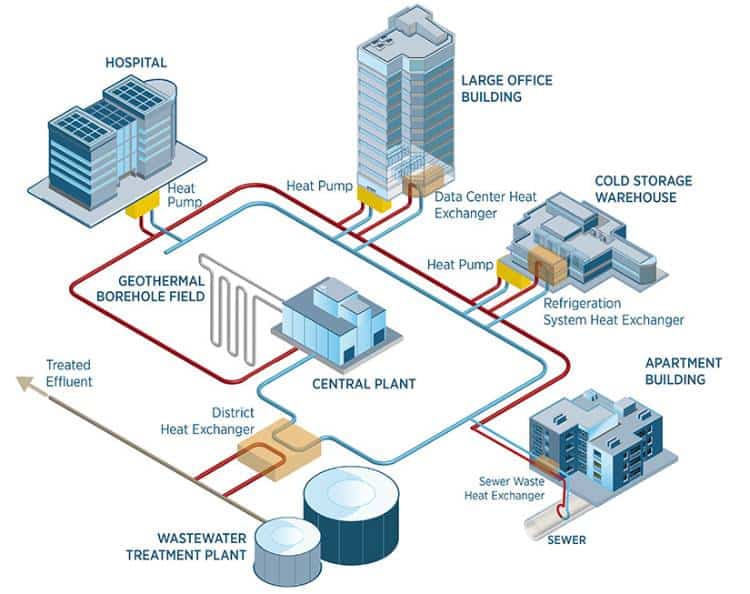Geothermal Heat Pumps
Heat pumps move heat from one place to another using electricity. Air conditioners and refrigerators are two common examples of heat pumps. Earth’s natural temperature resources can be used with heat pump technology to heat and cool buildings. Temperatures at about 30 feet below the surface remain relatively constant year-round—between about 50°F (10°C) and 59°F (15°C). For most areas in the United States, this means soil temperatures are usually warmer than the air in winter and cooler than the air in summer.1U.S. Dept. of Energy, Office of Energy Efficiency & Renewable Energy. (n.d.). Geothermal Heat Pumps. (accessed 2023, July 5). https://www.energy.gov/eere/geothermal/geothermal-heat-pumps

Geothermal heat pumps (GHP), also known as ground source heat pumps, take advantage of these constant underground temperatures to efficiently exchange temperatures, heating homes in the winter and cooling homes in the summer. GHPs exchange heat with the subsurface, often through a vertical shallow borehole as shown in this animation. A GHP delivers heating in the cold season and cooling in the warm season. The system does not burn fuel to generate heat, but rather it transfers heat from the subsurface to the space at the surface. Thus, GHPs are highly efficient.2U.S. Dept. of Energy, Office of Energy Efficiency & Renewable Energy. (n.d.). Geothermal Heat Pumps. (accessed 2023, July 5). https://www.energy.gov/eere/geothermal/geothermal-heat-pumps
Geothermal Heat Pump System Components
A geothermal heat pump system includes three components, as described below:3U.S. Dept. of Energy, Office of Energy Efficiency & Renewable Energy. (n.d.). Geothermal Heat Pumps. (accessed 2023, July 5). https://www.energy.gov/eere/geothermal/geothermal-heat-pumps
- An underground heat collector—A geothermal heat pump uses the earth as a heat source and sink (thermal storage), using a series of connected pipes buried in the ground near a building. The loop can be buried either vertically or horizontally. It circulates a fluid that absorbs or deposits heat to the surrounding soil, depending on whether the ambient (outside) air is colder or warmer than the soil.
- A heat pump—When ambient temperatures are colder than the ground, a geothermal heat pump removes heat from the collector’s fluids, concentrates it, and transfers it to the building. When ambient temperatures are warmer than the ground, the heat pump removes heat from the building and deposits it underground.
- A heat distribution subsystem—Conventional ductwork is generally used to distribute heated or cooled air from the geothermal heat pump throughout the building.
What direction does heat move in the winter, for example in New York, in a Geothermal Heat Pump?
Incorrect
Correct
Heat Collectors
Geothermal heat pumps use the constant underground temperatures of the shallow earth as thermal storage that enables efficient heating and cooling. Systems can vary in the type of collector and connections used.4U.S. Dept. of Energy, Office of Energy Efficiency & Renewable Energy. (n.d.). Geothermal Heat Pumps. (accessed 2023, July 5). https://www.energy.gov/eere/geothermal/geothermal-heat-pumps Some examples of heat exchangers used for geothermal heat pumps are illustrated in the diagram below:

GHPs do not require fracturing and they typically range from 3 to 90 meters (10 to 300 ft) in depth,7National Geographic. (n.d.). Geothermal Energy. National Geographic Education.(accessed 2023, July 5). https://education.nationalgeographic.org/resource/geothermal-energy but may be deeper in some cases. The closed loop systems pictured in the figure above use liquids to move heat. The slinky loops pictured in the two shallower examples promote strong temperature draw on surrounding soils.8Martin Energetics. (n.d.). “Slinky” loops and their engineering. (accessed 2023, July 5). https://www.martinenergetics.com/slinky-loop-engineering.html An example photograph of these heat pump coils illustrates how they maximize contact with subsurface temperatures.9Martin Energetics. (n.d.). “Slinky” loops and their engineering. (accessed 2023, July 5). https://www.martinenergetics.com/slinky-loop-engineering.html

In the summer, GHPs move heat from the surface to the subsurface to be cooled. In the winter, GHPs move heat from the subsurface to the surface to heat buildings. This is possible due to soil’s consistent temperature between 2 to 100 meters deep. Scientists measure soil temperature indirectly through groundwater temperature, and can display this information in a map form, as shown below.

What temperature of groundwater is NOT present in Texas?
Correct
Incorrect
Incorrect
Incorrect
Potential for Geothermal Heat Pumps
Geothermal heat pumps are already in operation in many locations across the United States, as well as globally. With the increased interest in direct use of geothermal, the U.S. National Renewable Energy Laboratory (NREL) is partnering with energy companies to develop district heating systems in select cities. Researchers are addressing geotechnical, economic, and logistical issues to understand the opportunities and challenges of using geothermal energy.
Austin, Texas has an estimated 21,000 vertical geothermal heat pump boreholes, likely the largest concentration of its kind across the nation.
Steve Kavanaugh10Kavanaugh, S. (Oct. 10, 2014). Ground source heat pumps in Texas School District. ASHRAE Journal, vol. 56, no. 10.
An example district heating system is illustrated from work by NREL below. In this example, for community-scale heating and cooling systems, geothermal boreholes are potentially drilled 10–500 feet deep. The boreholes provide interconnected buildings (districts) with constant temperatures that are used to both heat and cool buildings via heat pumps. The district uses pipes so water can circulate between buildings. In the summer, an energy station pumps cool water through pipes to buildings in the system. In the winter, hot water is pumped through the pipes while cool water returns to the energy station for reheating.11U.S. Dept. of Energy, National Renewable Energy Laboratory. (2023, March 7). Full Steam Ahead: Unearthing the Power of Geothermal. https://www.nrel.gov/news/features/2023/full-steam-ahead-unearthing-the-power-of-geothermal.html

Image Credits
- Geothermal-heat-pump-GHP-in-Winter-Summer: DOE EERE
- Geothermal-coils-Slinky-loops-FOGIT: Kody Nelson, The Future of Geothermal in Texas
- US-groundwater-temperatures-EPA: EPA
- 20230307-full-steam-ahead-unearthing-power-geothermal-cooling-heating-graphic-3: Marjorie Schott, NREL